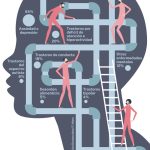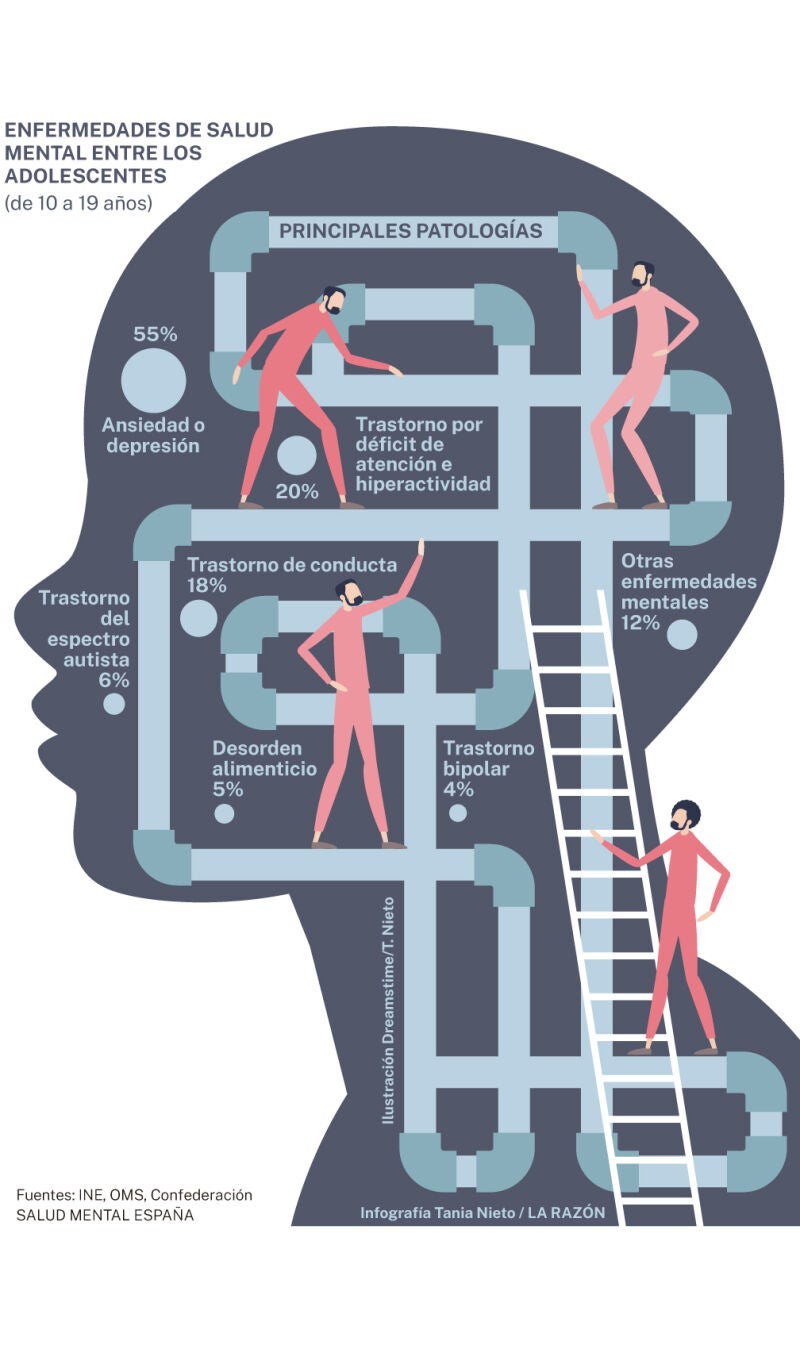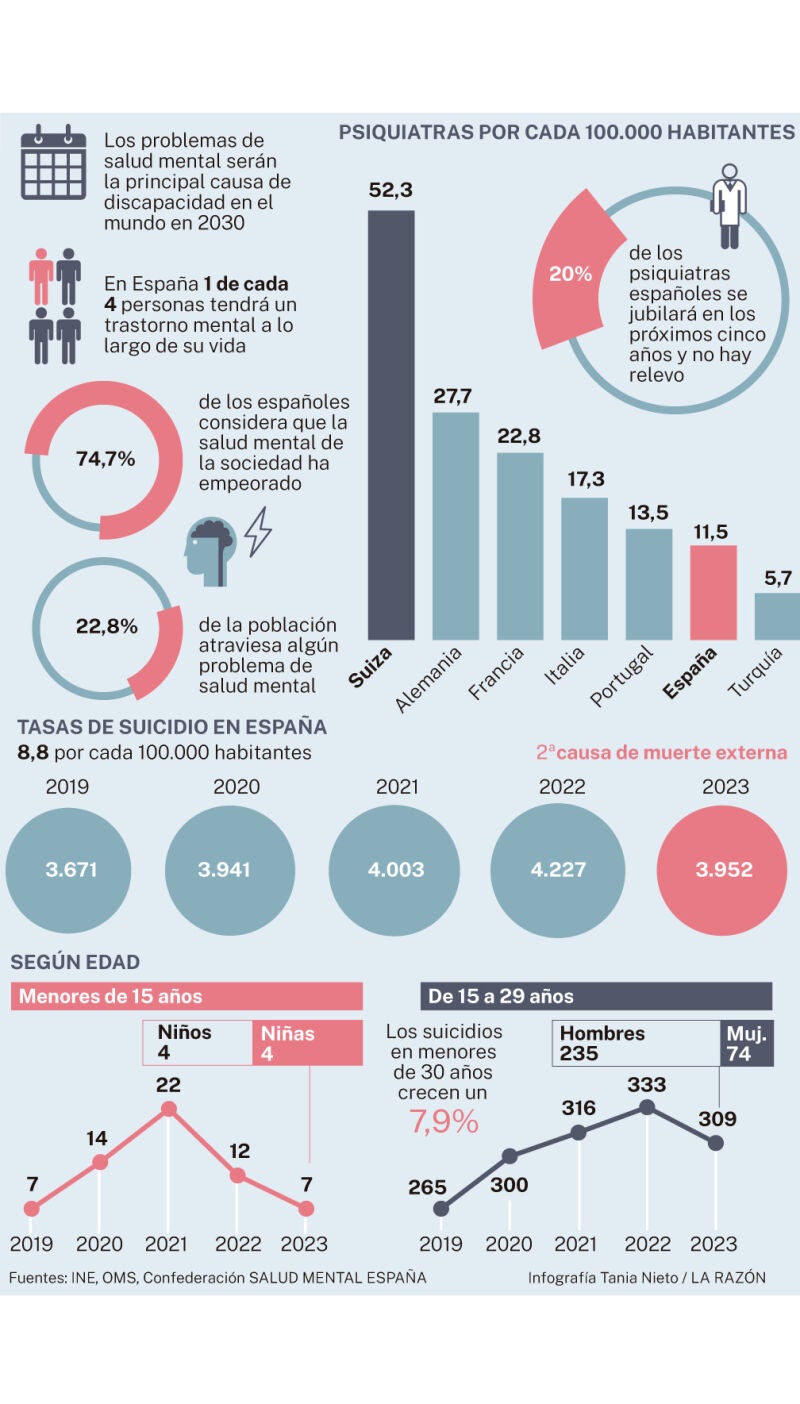

The data leaves no room for doubt. And they reflect a black reality: Spain is the third country in the European Union in which the most antidepressants are consumedonly surpassed by Portugal and Sweden, well above the average, while The daily use of these medications has grown by 50% in recent yearsaccording to data from the National Health System.
Minors are not immune to this statistic either, a group in which the intake of this type of drug has skyrocketed in recent years. Specifically, according to a recent study published this year in the scientific journal «Pediatrics»he increase in antidepressant consumption was 64% compared to pre-pandemic data. This increase is particularly pronounced among women, with rates that rose significantly compared to men. In fact, among the adolescents from 12 to 17 years old, the increase was 130%, while among the young adults ages 18 to 25 rose 60%.
«It is a upward trend that is common in all developed countries. And Spain is not far behind. With the pandemic, mental health problems skyrocketed, straining the health system, which has not yet recovered, because resources remain scarce and the pressure on care is very high. On the contrary, the problem is becoming chronic. The figures now seem to be somewhat more stable, but they are still very high and very worrying,” warns Pedro J. Rodríguez Hernándezpresident of the Society of Child Psychiatry (SPI).
A multifactorial pathology
Behind the increase in the use of antidepressants in minors is the tsunami of mental health problemsamong which depression stands out, “a multifactorial pathology that we see on the increase because now people abuse New technologies and social networks cause contagion phenomena, with greater risk of harassment, loss of self-esteem, insecurity…. And social changes do not help either, family conflicts or the difficulties for conciliation that cause children to be alone in front of a screen and without control from a very early age,” justifies Rodríguez Hernández.
Specifically, “in general terms, it is estimated a prevalence of depression in children 1-2%increasing in the adolescence up to 3-8%. In fact, the 34% of young people worldwide between 10 and 19 years old are at risk of developing a depressive disorder. Furthermore, we must not forget that early detection of depression and any other psychiatric disorder is very important, since 50% of all of them appear in adolescence,” he points out. Maria Vallejopsychiatrist at the Child and Adolescent Psychiatry Unit at the University of Navarra Clinic.
With these data on the table, it is not surprising that the consumption of antidepressants has skyrocketed in recent years. But, as he explains Iria Rodríguez, child and adolescent psychiatrist at the HM Puerta del Sur hospital in Madrid, “they are not prescribed only to treat depression, since they are also prescribed for anxiety, obsessive-compulsive disorders, etc. In fact, “The first line of care for child and adolescent depression is psychotherapy and only in the most serious cases are drugs chosen.”
In this sense, Gloria Bellidocoordinator of the children’s section of the Spanish Society of Clinical Psychology (SEPC), clarifies that “depression in minors usually involves emotional disorders which translate into irritability, restlessness, sadness, behavioral changes, and isolationappearing alterations in sleep, appetite and general discomfort. In adolescence it is more similar to adults, with apathy and decline, although irritability predominates in young people.
Once the problem is detected, experts agree on the urgency of putting yourself in the hands of a specialist, although the reality is that it is not always easy. «The waiting list is very long and there is a lot of inequality between autonomiesthat is why it is essential to achieve recognition of the specialty of Child and Adolescent Psychology to increase the ratio of professionals. The tsunami of mental health in young people is already a reality and we cannot take any longer to act,” warns Bellido.

Aware of this is Mercedes Navíopsychiatrist and coordinator of the Regional Office of Mental Health and Addictions of the Madrid Health Service, who confirms that “the pandemic was a catalyst that revealed the need for more resources. It is a priority objective for us, that is why Very soon we will open new facilities dedicated to the mental health of young people in the region ».
With the diagnosis already confirmed, “the approach to depression combines pharmacological treatment (antidepressants and anxiolytics) and psychotherapeutic treatment (individual and family)», explains Vallejo, who details that «they are very effective and safe drugs. Parents are afraid that their child will be prescribed an antidepressant, but what is really toxic to the brain is accumulating anxiety or depression».
The reality is that “being strict should we only use fluoxetine to treat childhood depressionbecause it is an antidepressant whose use is approved in children. In patients under eight years old, only this option tends to be used, but in those who are a little older people or adolescents use drugs for adults. The key in these cases is to be cautious, apply the lowest possible dose and maintain very strict control so that, As soon as the situation stabilizes, the medication can be withdrawn», describes Rodríguez. And, according to the HM Puerta del Sur psychiatrist, “it is important to clarify that benzodiazepinescommonly known as tranquilizers, They are not usually used in minors because they can cause a paradoxical reaction, that is, instead of calming the child, they agitate them. In addition, they have a significant addictive potential and we have to increase the dose because the body gets used to it. This should not be confused with antidepressants, which are very safe and used because they have been shown to improve depression in children and without side effects. In fact, This disease can be cured and does not leave long-term consequences.».

Given the increase in depression problems in young people, science is already working on research of new drugs and molecules “which are demonstrating effectiveness in the most resistant depressive disorders or those with suicidal thoughts,” adds Vallejo, who recalls that “suicide is the greatest complication of depression and one of the most frequent causes of external death among young people.” Therefore, Investing in prevention is the best tool to stop it.